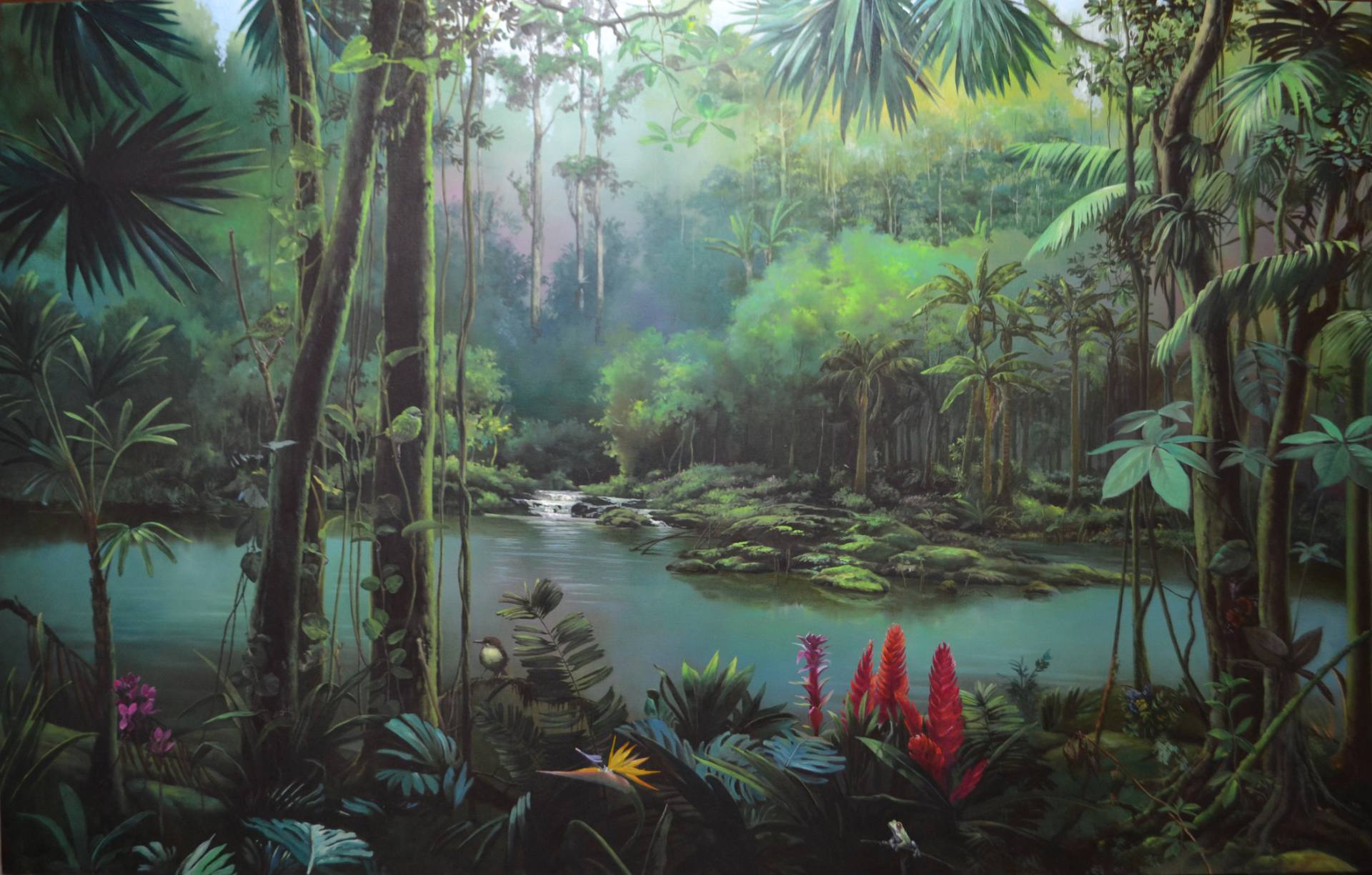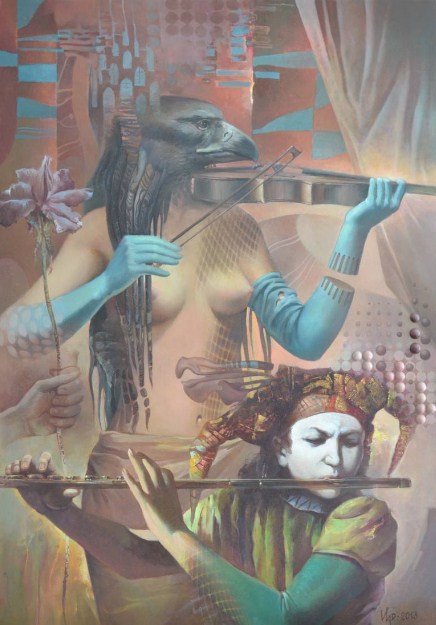
018 Forest fairy Painting by Vlad Tasoff
Painting: Oil on Canvas.
The forest as a place of magic and danger is found among folklore wherever the natural state of wild land is forest: a forest is a location beyond which people normally travel, where strange things might occur, and strange people might live, the home of monsters, witches and fairies.
Keywords: Enchanted forest, fairy tale, magic creatures, mythological characters, Folklore mythology
Find out more

Abstract composition #1 Painting by Vlad Tasoff
Oil painting on canvas. Abstract composition Vlad Tasoff, now available for sale. Size of work: 19,7 x 25,7 inches. Price 511$ https://www.saatchiart.com/art/Painting-Abstract-composition-1/729923/2551364/view or contact us: vlta2006@yahoo.com
“Of all the arts, abstract painting is the most difficult. It demands that you know how to draw well, that you have a heightened sensitivity for composition and for colours, and that you be a true poet. This last is essential.” — Wassily Kandinsky.
Kandinsky believed that colors provoke emotions. Red was lively and confident; Green was peaceful with inner strength; Blue was deep and supernatural; Yellow could be warm, exciting, disturbing or totally bonkers; and White seemed silent but full of possibilities. He also assigned instrument tones to go with each color: Red sounded like a trumpet; Green sounded like a middle-position violin; Light Blue sounded like flute; Dark Blue sounded like a cello, Yellow sounded like a fanfare of trumpets; and White sounded like the pause in a harmonious melody.
When you paint, you always refer to something. If it isn’t to the outside world, it is to your own body, or mood, something you know, or the idea you have in mind while you paint. My experience is: when you paint without having any subject in mind, you create a depiction of yourself, or the way you are or feel at that moment. Sometimes even organs like the heart or the kidneys can be pointed out on a painting like that. This body-thing is important, because in abstract painting techniques, you actually work with the thinking capacity of your body. Just like graffity-painters and dancers do. And: when you conciously relate to your painting with your body, you will enable your onlookers to do the same, and feel their way into your painting. When you let go of the outer appearance of things, delivered by the eyes, the body is the first thing you have in common with your onlookers.

Abstract composition #4 Vlad Tasoff
Oil painting on canvas. Abstract composition Vlad Tasoff, now available for sale. Size of work: 18,9 x 32,7 inches. Price 404$. https://www.saatchiart.com/art/Painting-Abstract-composition-4/729923/2633282/view or contact us: vlta2006@yahoo.com
“Of all the arts, abstract painting is the most difficult. It demands that you know how to draw well, that you have a heightened sensitivity for composition and for colours, and that you be a true poet. This last is essential.” — Wassily Kandinsky.
Kandinsky believed that colors provoke emotions. Red was lively and confident; Green was peaceful with inner strength; Blue was deep and supernatural; Yellow could be warm, exciting, disturbing or totally bonkers; and White seemed silent but full of possibilities. He also assigned instrument tones to go with each color: Red sounded like a trumpet; Green sounded like a middle-position violin; Light Blue sounded like flute; Dark Blue sounded like a cello, Yellow sounded like a fanfare of trumpets; and White sounded like the pause in a harmonious melody.
When you paint, you always refer to something. If it isn’t to the outside world, it is to your own body, or mood, something you know, or the idea you have in mind while you paint. My experience is: when you paint without having any subject in mind, you create a depiction of yourself, or the way you are or feel at that moment. Sometimes even organs like the heart or the kidneys can be pointed out on a painting like that. This body-thing is important, because in abstract painting techniques, you actually work with the thinking capacity of your body. Just like graffity-painters and dancers do. And: when you conciously relate to your painting with your body, you will enable your onlookers to do the same, and feel their way into your painting. When you let go of the outer appearance of things, delivered by the eyes, the body is the first thing you have in common with your onlookers.

Jungle Painting Vlad Tasoff
Jungle painting Vlad Tasoff, Original oil on canvas, 2014, This painting had been done by Vlad Tasoff after travel to the Ecuadorian rainforest.
This picture filled with the numerous hidden details – butterflies, birds, various insects living in rainforest.
The word Jungle originates from the Sanskrit word jangala (Sanskrit: जङ्गल), meaning uncultivated land. Although the Sanskrit word refers to dry land, it has been suggested that an Anglo-Indian interpretation led to its connotation as a dense “tangled thicket” while others have argued that a cognate word in Urdu did refer to forests The term is prevalent in many languages of the Indian subcontinent, and the Iranian plateau, where it is commonly used to refer to the plant growth replacing primeval forest or to the unkempt tropical vegetation that takes over abandoned areas.One of the most common meanings of jungle is land overgrown with tangled vegetation at ground level, especially in the tropics. Typically such vegetation is sufficiently dense to hinder movement by humans, requiring that travelers cut their way through. This definition draws a distinction between primary forest and jungle, since the under-storey of tropical forests is typically open of vegetation due to a lack of sunlight, and hence relatively easy to traverse.[Jungles may exist within, or at the borders of, tropical forests in areas where the forest has been opened through natural disturbance such as hurricanes, or through human activity such as logging. The vegetation that springs up following such disturbance of is dense and impenetrable and is a ‘typical’ jungle. Jungle also typically forms along forest margins and along stream banks, once again due to the greater available light at ground level.Because jungles occur on all inhabited landmasses and may incorporate numerous vegetation and land types, the wildlife of jungles cannot be defined and consists of the biota of the land type and region.

















